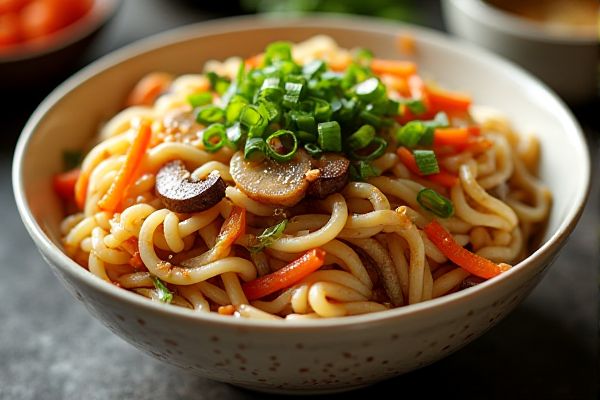
Japanese Pan Noodles from Noodles & Company feature tender egg noodles stir-fried with savory shiitake mushrooms, crisp cabbage, and julienned carrots, all tossed in a flavorful soy-ginger sauce, garnished with fresh scallions for a vibrant and satisfying meal.
Equipments
- Wok or large nonstick skillet
- Mixing bowls
- Chef’s knife
- Cutting board
- Tongs or spatula
- Saucepan (for noodles)
- Colander or strainer
- Measuring cups and spoons
Ingredients
- 8 oz (225g) Japanese udon or wide egg noodles
- 2 tablespoons vegetable oil
- 1 cup shiitake mushrooms, sliced
- 1 cup green cabbage, shredded
- 1 cup carrots, julienned
- 3 tablespoons soy sauce
- 2 tablespoons dark soy sauce
- 1 tablespoon mirin
- 1 tablespoon brown sugar
- 1 tablespoon ginger, minced
- 2 cloves garlic, minced
- 2 teaspoons sesame oil
- 2 scallions, sliced
Using fresh shiitake mushrooms and crisp cabbage will enhance the authentic texture and flavor of the Japanese Pan Noodles. Udon or wide egg noodles work best for achieving the tender, chewy consistency typical in this dish, so choose wisely at your grocery store. The combination of soy sauce, dark soy sauce, and mirin creates a balanced soy-ginger sauce; be sure to measure these ingredients accurately to maintain the right savory-sweet profile. Minced ginger and garlic add essential aromatic depth that elevates the stir-fry, while sesame oil and fresh scallions provide a finishing touch of richness and color. You'll enjoy recreating the popular Japanese Pan Noodles from Noodles & Company with this copycat recipe that captures its vibrant flavors.
Instructions
- Cook noodles according to package instructions; drain and set aside.
- In a mixing bowl, whisk together soy sauce, dark soy sauce, mirin, brown sugar, ginger, and garlic.
- Heat 1 tablespoon vegetable oil in a wok over medium-high heat.
- Add shiitake mushrooms; stir-fry until softened, about 2 minutes.
- Add cabbage and carrots; stir-fry until just tender, about 2-3 minutes.
- Push vegetables to the side; add remaining 1 tablespoon oil and cooked noodles to the wok.
- Pour sauce mixture over noodles and vegetables; toss to combine evenly.
- Stir-fry for 2-4 minutes, until noodles are heated through and coated.
- Drizzle sesame oil over the noodles and toss well.
- Transfer to serving dishes and garnish with sliced scallions.
Substitution
Japanese Pan Noodles from Noodles & Company copycat recipe relies on wide egg noodles or udon for authentic texture; if these are unavailable, you can substitute with fettuccine or other broad pasta types. Shiitake mushrooms provide a distinctive umami flavor, but baby bella or button mushrooms work well in a pinch. Vegetable oil can be replaced by canola or peanut oil to maintain high-heat cooking without smoke. Mirin may be swapped with a mixture of sake and sugar if needed to match the sweetness and acidity. Ensure you adjust soy sauce quantities to match your taste preferences and dietary requirements for sodium content.
Tips
Ensure your noodles are cooked al dente to prevent mushiness when stir-fried. Use a sufficiently hot wok or skillet to achieve a quick sear on vegetables and mushrooms, preserving their crisp texture and vibrant flavor. When adding the sauce, toss immediately to coat the noodles and vegetables evenly, which enhances the overall taste and prevents clumping. You should add the sesame oil last to maintain its aromatic flavor, giving your Japanese Pan Noodles an authentic, fragrant finish.
Nutritions
Japanese Pan Noodles provide a balanced combination of carbohydrates, fiber, and essential vitamins from the egg noodles, shiitake mushrooms, cabbage, and carrots. The shiitake mushrooms contribute important antioxidants and B vitamins, while the cabbage and carrots add dietary fiber and vitamin A. The soy-ginger sauce offers a savory flavor and some sodium, so you should monitor seasoning to fit your dietary needs. Sesames oil and vegetable oil supply healthy fats that enhance nutrient absorption and flavor.
Storage
Store your Japanese Pan Noodles in an airtight container in the refrigerator to maintain freshness and flavor for up to 3 days. To prevent the noodles from sticking together, lightly toss them with a small amount of sesame oil before refrigeration. When reheating, use a wok or skillet over medium heat to evenly warm the noodles and restore their original texture.
Variation or Alternatives
Swap shiitake mushrooms with cremini or oyster mushrooms for a different earthy flavor. You can substitute green cabbage with bok choy or napa cabbage to add a subtle sweetness and crunch. For an extra protein boost, toss in cooked tofu, chicken, or shrimp during the stir-fry stage. Adjust the soy-ginger sauce by adding a splash of rice vinegar or a pinch of red pepper flakes to tailor the dish to your taste preferences.
Allergies
Japanese Pan Noodles contain potential allergens such as egg in the noodles and soy in both the soy sauce and dark soy sauce. Sesame oil may also trigger reactions in individuals with sesame allergies, while garlic and ginger can cause sensitivities for some people. Your awareness of these ingredients is important to avoid adverse allergic reactions.
Why this recipe?
Japanese Pan Noodles from Noodles & Company feature a perfect balance of savory soy-ginger sauce, tender chicken, and fresh vegetables, delivering an authentic taste of Japanese cuisine. The dish combines smoky pan-seared noodles with bold flavors and a satisfying texture that appeals to a wide range of palates. You will appreciate how making a copycat version allows you to customize ingredients and enjoy the same restaurant-quality meal at home. Recreating this popular menu item offers a rewarding cooking experience and the chance to savor a beloved favorite anytime.
